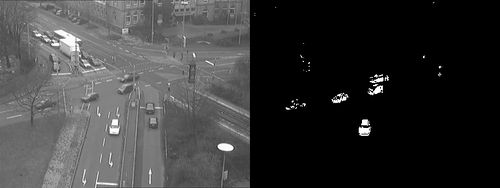Difference between revisions of "Example Background Stationary Camera"
From BoofCV
Jump to navigationJump to searchm |
m |
||
| Line 8: | Line 8: | ||
Example File: | Example File: | ||
* [https://github.com/lessthanoptimal/BoofCV/blob/v0. | * [https://github.com/lessthanoptimal/BoofCV/blob/v0.23/examples/src/boofcv/examples/tracking/ExampleBackgroundRemovalStationary.java ExampleBackgroundRemovalStationary.java] | ||
Concepts: | Concepts: | ||
| Line 35: | Line 35: | ||
// Comment/Uncomment to switch input image type | // Comment/Uncomment to switch input image type | ||
ImageType imageType = ImageType.single( | ImageType imageType = ImageType.single(GrayF32.class); | ||
// ImageType imageType = ImageType.il(3, InterleavedF32.class); | // ImageType imageType = ImageType.il(3, InterleavedF32.class); | ||
// ImageType imageType = ImageType.il(3, InterleavedU8.class); | // ImageType imageType = ImageType.il(3, InterleavedU8.class); | ||
| Line 56: | Line 56: | ||
// Declare storage for segmented image. 1 = moving foreground and 0 = background | // Declare storage for segmented image. 1 = moving foreground and 0 = background | ||
GrayU8 segmented = new GrayU8(video.getNextWidth(),video.getNextHeight()); | |||
BufferedImage visualized = new BufferedImage(segmented.width,segmented.height,BufferedImage.TYPE_INT_RGB); | BufferedImage visualized = new BufferedImage(segmented.width,segmented.height,BufferedImage.TYPE_INT_RGB); | ||
Revision as of 04:46, 28 March 2016
Example of background modeling/motion detection from a stationary camera. Moving objects are detected inside the video based on their difference from a background model. These techniques can run very fast (basic runs over 2,000 fps) and be very effective in tracking algorithms
Example File:
Concepts:
- Motion Detection
- 2D Image Stitching
Related Examples:
Example Code
/**
* Example showing how to perform background modeling when the camera is assumed to be stationary. This scenario
* can be computed much faster than the moving camera case and depending on the background model can some times produce
* reasonable results when the camera has a little bit of jitter.
*
* @author Peter Abeles
*/
public class ExampleBackgroundRemovalStationary {
public static void main(String[] args) {
String fileName = UtilIO.pathExample("background/street_intersection.mp4");
// String fileName = UtilIO.pathExample("background/horse_jitter.mp4"); // degraded performance because of jitter
// String fileName = UtilIO.pathExample("tracking/chipmunk.mjpeg"); // Camera moves. Stationary will fail here
// Comment/Uncomment to switch input image type
ImageType imageType = ImageType.single(GrayF32.class);
// ImageType imageType = ImageType.il(3, InterleavedF32.class);
// ImageType imageType = ImageType.il(3, InterleavedU8.class);
// Configuration for Gaussian model. Note that the threshold changes depending on the number of image bands
// 12 = gray scale and 40 = color
ConfigBackgroundGaussian configGaussian = new ConfigBackgroundGaussian(12,0.0005f);
configGaussian.initialVariance = 100;
configGaussian.minimumDifference = 10;
// Comment/Uncomment to switch algorithms
BackgroundModelStationary background =
// FactoryBackgroundModel.stationaryBasic(new ConfigBackgroundBasic(35, 0.005f), imageType);
FactoryBackgroundModel.stationaryGaussian(configGaussian, imageType);
MediaManager media = DefaultMediaManager.INSTANCE;
SimpleImageSequence video =
media.openVideo(fileName, background.getImageType());
// media.openCamera(null,640,480,background.getImageType());
// Declare storage for segmented image. 1 = moving foreground and 0 = background
GrayU8 segmented = new GrayU8(video.getNextWidth(),video.getNextHeight());
BufferedImage visualized = new BufferedImage(segmented.width,segmented.height,BufferedImage.TYPE_INT_RGB);
ImageGridPanel gui = new ImageGridPanel(1,2);
gui.setImages(visualized, visualized);
ShowImages.showWindow(gui, "Static Scene: Background Segmentation", true);
double fps = 0;
double alpha = 0.01; // smoothing factor for FPS
while( video.hasNext() ) {
ImageBase input = video.next();
long before = System.nanoTime();
background.segment(input,segmented);
background.updateBackground(input);
long after = System.nanoTime();
fps = (1.0-alpha)*fps + alpha*(1.0/((after-before)/1e9));
VisualizeBinaryData.renderBinary(segmented, false, visualized);
gui.setImage(0, 0, (BufferedImage)video.getGuiImage());
gui.setImage(0, 1, visualized);
gui.repaint();
System.out.println("FPS = "+fps);
try {Thread.sleep(5);} catch (InterruptedException e) {}
}
System.out.println("done!");
}
}
